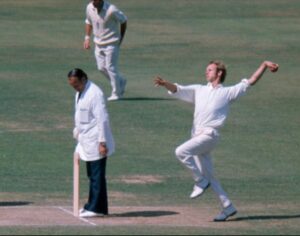
Derek Underwood had earned the sobriquet ‘Deadly’ because he was deadly on sticky dogs (damp pitches). Also, he was deadly accurate.
“He was a great bowler,”DilipVengsarkar told RevSportz. “Very accurate. He used to bowl fantastic lineandlength. You couldn’t drive him effortlessly or cut him. That kind of length he would bowl.”
The former England left-arm spinner passed away on Monday and Vengsarkar, who played against him during England’s tour of India in 1981-82, spoke about the degree of difficulty. “He was faster in the air and especially on a slightly helpful pitch, he was unplayable.”
Underwood had a stellar 24-year first-class career for Kent. From 1963 to 1987, he featured in 676 matches, claiming 2,465 wickets at an average of 20.28. Pretty apt that Kent Cricket’s chair, Simon Philip, came up with a touching tribute. “The Kent Cricket family is in mourning following the passing of one of its greatest ever players,” he said. “Derek was an outstanding contributor to both Kent and England, winning trophies for Club and country and etching his name in the history books forevermore. Watching Derek weave his unique magic on a wet wicket was a privilege for all who were able to witness it.”
Underwood made his Test debut in 1966, and over 86 games, he took 297 wickets at 25.83. For so long, he was the benchmark for England spinners. During the 1976-77 tour of India, he had 29 wickets from five Tests at an average of 17.55. In 1981-82, he played three Tests and took six wickets at an average of 15.33. “The way he bowled in India, it was amazing,” said Vengsarkar. “He bowled brilliantly.”
Underwood had the advantage of playing a significant part of his career on uncovered pitches. Total pitch covering during games was introduced in England in the late 1970s, and the way Underwood bowled, he thrived on sticky wickets. Was he equally effective after pitch cover was introduced? “Yeah, he was effective,” said Vengsarkar. “In 1981, I played him in India when he came under Keith Fletcher’s captaincy. He was excellent. He was so accurate he would bowl nine balls out of 10 on a coin.”
Underwood played at a time when India had the famous spin quartet of Bishan Bedi, Bhagwat Chandrasekhar, Erapalli Prasanna and S Venkataraghavan. Bedi, a maverick unlike Underwood, was also a left-arm spinner. But he was completely different. Vengsarkar gave the low-down. “Yes, they were different types of spinners. From mindset to action and variations, they were different. I can’t compare them. Both were great bowlers.”
So, from a batter’s point of view, how did one score runs against Underwood? “You have to wait and wait, and grind for your runs,” said Vengsarkar. “He won’t give you anything and would make you work hard for every run. Also, having Alan Knott behind the stumps helped Underwood. Those days, Knott was one of the best in the world, along with our Farokh Engineer. So having Knott as wicketkeeper definitely helped.”
Back then, cricket was different, a lot more conventional to be precise. The reverse-sweep was virtually non-existent, so were the ramp and the lap. “Yes, we played every ball on its merit,” said Vengsarkar before moving into the great match-up between Underwood and Sunil Gavaskar. “There was always a great tussle between bat and ball when they played.”
For more sports related content : https://revsportz.in/